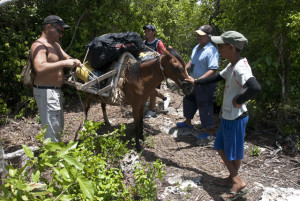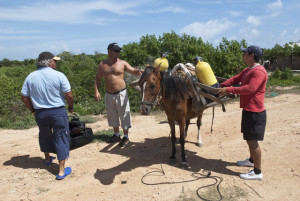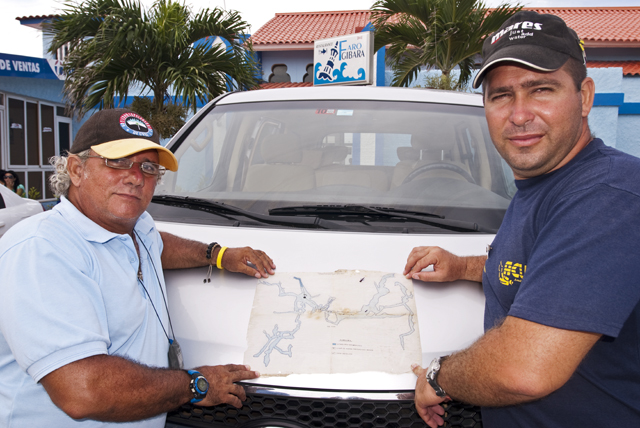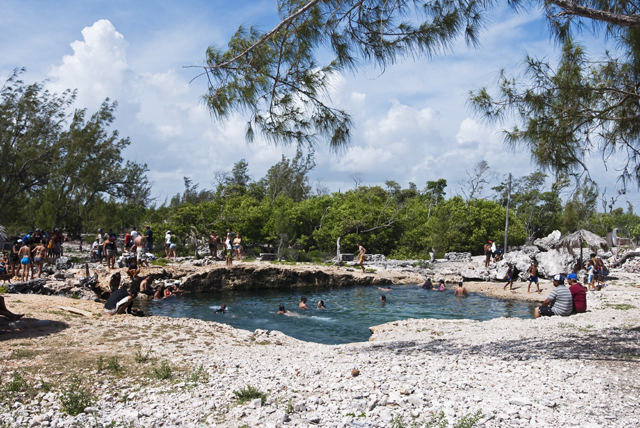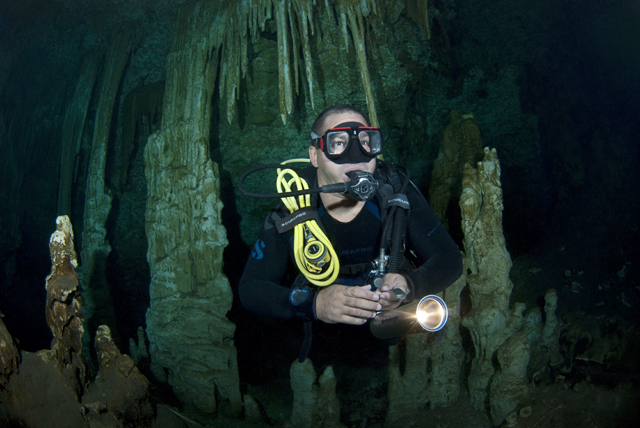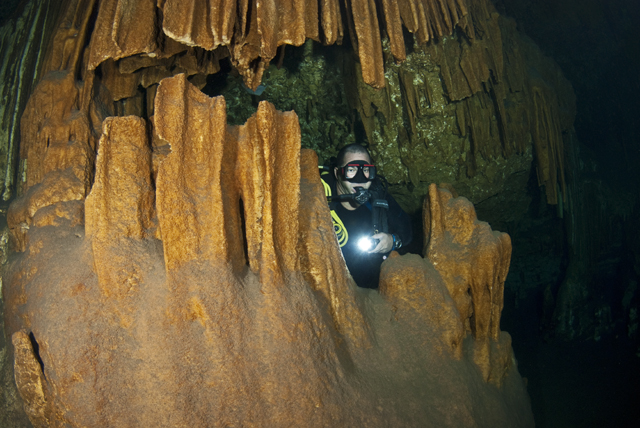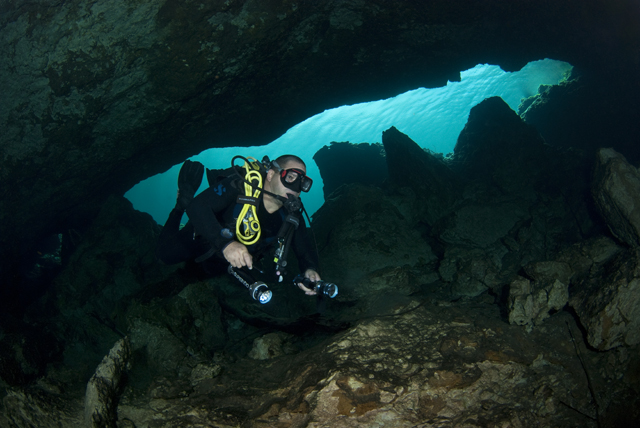News
Rumble in the Jungle: Cave Diving in Cuba
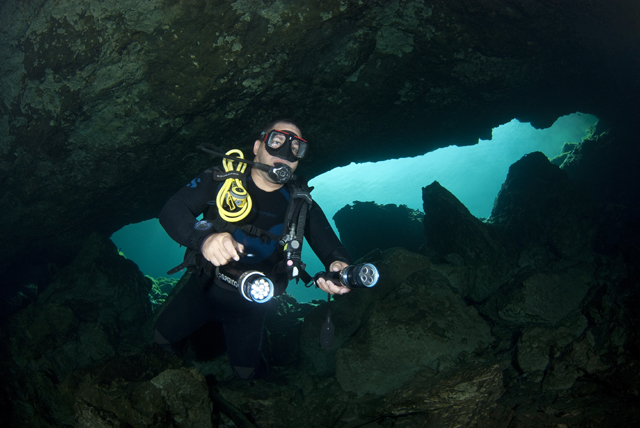
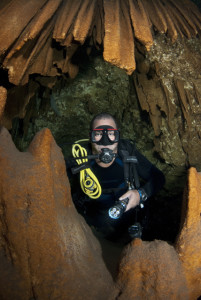 I was busy humming the Indiana Jones theme tune as we made our way through the jungle. This was by no means a ‘normal’ diving day and had turned out to be a real life adventure complete with the full entourage of creepy crawlies. Our tropical surroundings were alive with squawking Birds, Crabs, Geckos, Snakes (not poisonous I might add) and other exotic bugs. I was definitely experiencing raw Cuba at its very best. Jorge Millet Corchete, the Manager of Eagle Ray Dive Centre, had told me about two, virtually un-dived, underwater cave systems located 70km from the popular beach resort at Guardalavaca. After buttering me up with the exciting bits he then hit me with the bad news: the first cave system, known as Ring Hole, was a 1km walk through dense bush in the swelteringly hot sunshine. Worst still, the second system called Blue Tank, which in Jorge’s mind was much better for photographs, clocked in at more than 3km’s from the drop off point. Why are the best sites always the furthest away and hardest to get too? The saying ‘no pain, no gain’ came to mind as I mentally prepared myself for the cardiac inducing hike.
I was busy humming the Indiana Jones theme tune as we made our way through the jungle. This was by no means a ‘normal’ diving day and had turned out to be a real life adventure complete with the full entourage of creepy crawlies. Our tropical surroundings were alive with squawking Birds, Crabs, Geckos, Snakes (not poisonous I might add) and other exotic bugs. I was definitely experiencing raw Cuba at its very best. Jorge Millet Corchete, the Manager of Eagle Ray Dive Centre, had told me about two, virtually un-dived, underwater cave systems located 70km from the popular beach resort at Guardalavaca. After buttering me up with the exciting bits he then hit me with the bad news: the first cave system, known as Ring Hole, was a 1km walk through dense bush in the swelteringly hot sunshine. Worst still, the second system called Blue Tank, which in Jorge’s mind was much better for photographs, clocked in at more than 3km’s from the drop off point. Why are the best sites always the furthest away and hardest to get too? The saying ‘no pain, no gain’ came to mind as I mentally prepared myself for the cardiac inducing hike.
Jorge said at the beginning they used to cover the journey in rented 4 x 4’s but the hire companies got wise when the Jeeps kept coming back completely trashed. Jorge seemed to think that the gentle ‘stroll’ added an extra ‘feel good factor’ to the whole experience. I didn’t have quite as many positive vibes as Jorge but after some gentle persuasion (one or two Mojitos – I’m cheap!) I agreed to take part in the event.
We stopped off at the town of Gibara along the way to pick up some 4-legged help. Jorge’s friend Floro owned the Mule that we were using to carry all our diving equipment. I asked Floro what the Mule was called but he told me that it changed daily depending on how he felt. I decided to call the Mule ‘Pepe’ as it seemed quite appropriate for this neck of the woods.
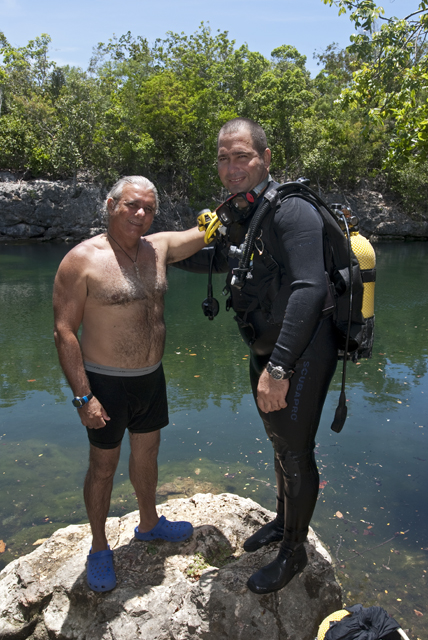 We had also picked up Jose Corella, the local cave diving Guru. Jose, a Geologist by trade, had been diving inside the caves since the late 80’s and had clocked up more than 300 deep penetration dives. He became fascinated by above water caves from an early age. Military friends introduced him to the Blue Tank and the rest was now history. Jose showed me the detailed maps he had made of the cave systems. He had chartered more than 3,000 metres inside the Blue Tank and so far had not reached an ending in any of the 3 independent entrances. Jose had a theory that Ring Hole may well join up to the Blue Tank, it’s just that no one had tried to find out. As well as making maps Jose had laid most of the 3,000 metres of line complete with directional arrows for other divers to follow. As far as Jose knew Czech divers were the first to explore the caves back in 1982. Eagle Ray Dive Centre began offering guided dives to UK tourists in 2004. Jorge said that divers have to be minimum PADI Advanced qualified to explore in the light zone (around the entrances) and he prefers them to do several standard sea dives before venturing inside the caves. This gave Jorge a chance to check the divers out and see how comfortable they were in the water. Jorge said he would only take certified cave divers deeper inside. So far there have been no serious incidents at Ring Hole or the Blue Tank.
We had also picked up Jose Corella, the local cave diving Guru. Jose, a Geologist by trade, had been diving inside the caves since the late 80’s and had clocked up more than 300 deep penetration dives. He became fascinated by above water caves from an early age. Military friends introduced him to the Blue Tank and the rest was now history. Jose showed me the detailed maps he had made of the cave systems. He had chartered more than 3,000 metres inside the Blue Tank and so far had not reached an ending in any of the 3 independent entrances. Jose had a theory that Ring Hole may well join up to the Blue Tank, it’s just that no one had tried to find out. As well as making maps Jose had laid most of the 3,000 metres of line complete with directional arrows for other divers to follow. As far as Jose knew Czech divers were the first to explore the caves back in 1982. Eagle Ray Dive Centre began offering guided dives to UK tourists in 2004. Jorge said that divers have to be minimum PADI Advanced qualified to explore in the light zone (around the entrances) and he prefers them to do several standard sea dives before venturing inside the caves. This gave Jorge a chance to check the divers out and see how comfortable they were in the water. Jorge said he would only take certified cave divers deeper inside. So far there have been no serious incidents at Ring Hole or the Blue Tank.
We drove to a clearing and waited for Pepe the Mule to arrive. Jorge, an ex-Cuban Navy SEAL, had stripped down to his waist and was raring to go. I followed Jorge’s lead by ripping off my t-shirt and slapping on a good helping of factor 30. I had put the Strobes and other camera/dive gear into my rucksack which now weighed in at around 15kg’s. I thought it would be best to carry my housing and camera by hand. In no time at all Pepe had arrived, was packed, had a poo and began trotting down the jungle path. I followed along behind Jorge and Jose (dodging Pepe’s fall out). The track was mainly made up of broken uneven rocks making it very difficult to walk on. My flip-flops weren’t exactly the most appropriate footwear for this kind of terrain. I managed to stub my toes (and swore) a number of times. I asked Jose why they hadn’t made a proper pathway to the Blue Tank and he said that this would only encourage more locals to visit the spot and he preferred to keep them away. He told me there had been a 30 metre long underwater tunnel connecting the town’s popular swimming hole to the open sea. Authorities decided to block up the entrance, with a controlled explosion, after a number of people drowned trying to breath hold swim through the tunnel. Jose didn’t want the caves to suffer a similar fate. Jorge said ‘nearly everyone moans about the walk and they constantly ask ‘are we there yet?’ but when they see inside the caves they are much happier and forget about the return journey’. Jose talked non-stop for the whole 3km’s, which was enough to distract me from the ever growing number of Mosquito blotches appearing all over me (I counted about 30 in total).
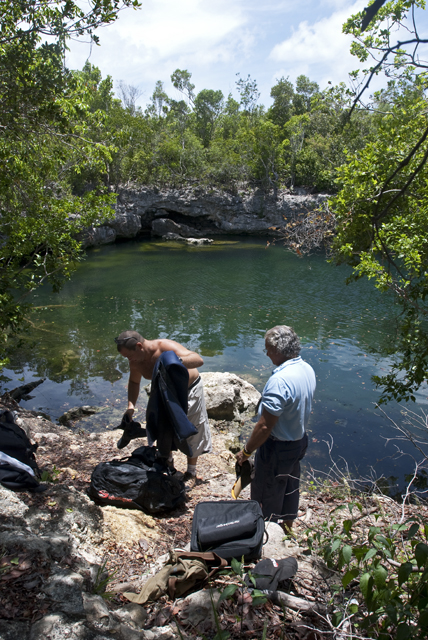 Jose said that the pond measured in at 30 x 15 metres. The seemingly ‘dead pool’ was surrounded by dense bushes and trees apart from one spot where there was a narrow pathway leading down to the water’s edge. Jorge saw a something break the mirror calm surface. A Turtle popped its head up and then quickly disappeared again. This is the first time he had ever seen a Turtle in the pond.
Jose said that the pond measured in at 30 x 15 metres. The seemingly ‘dead pool’ was surrounded by dense bushes and trees apart from one spot where there was a narrow pathway leading down to the water’s edge. Jorge saw a something break the mirror calm surface. A Turtle popped its head up and then quickly disappeared again. This is the first time he had ever seen a Turtle in the pond.
Jorge guided me to the first cave entrance which was big enough for at least six divers to enter side by side. The bottom of the pond was around 6-8 metres deep and covered in a thick luminous green layer of algae, branches and dead leaves. I stopped to take a picture of Jorge entering the cave and felt something feeding on my ankles. I looked down and saw hundreds of Prawns ‘cleaning’ any part of my skin they could find. The pond was far from dead. I had missed out on some really good Macro opportunities.
My equipment wasn’t adequate for a full-on penetration dive but I decided to take a risk and venture in more than 100m’s keeping a firm eye on the guideline and my air gauge needle. The inner chambers were massive with 2 metre long spiky Stalactites hanging from the roof and stubby Stalagmites growing up from the cave floor. When I’m taking photographs I sometimes use a finger touch on a rock just to steady myself. But as I touched the top of a small Stalagmite it broke off. It was only a small piece just a few cm’s long but I was absolutely mortified. It had been such a gentle touch. I had no idea that they were so fragile. I really did learn a valuable lesson and doubled my buoyancy efforts. A diver with bad buoyancy skills inside this cave would be equivalent to a Bull in a China shop – nothing would survive. Afterwards Jorge told me that the orange looking rock formations were much stronger than the white looking ones. I wish he had said something earlier!
The huge chambers (as a rough guide – the size of a Bungalow) were an impressive sight and the further I went in the scenery just got bigger and better. The chambers seem to alternate between all Stalagmites and then all Stalactites. Jorge said that the maximum depth he had ever reached inside the caves was around 18 metres with the average depth being 15 metres. Water temp hovered around 24 degrees. Jorge suddenly made an ‘ugh’ noise from his regulator and as I turned around I caught sight of an Eel about 500cm long swimming away from us. Jorge said there were also 2 species of indigenous blind fish living inside the caves.
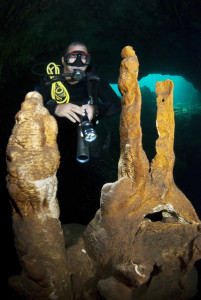
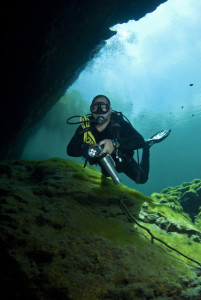 I made the mistake of putting my fins on the cave floor and found it was carpeted by a thick layer of silt. Within seconds my fin had totally sank into the soft quicksand. Even the slightest disturbance reduced the visibility dramatically. I was trying my best to ‘frog’ kick but my longish fins weren’t ideal for this type of environment.
I made the mistake of putting my fins on the cave floor and found it was carpeted by a thick layer of silt. Within seconds my fin had totally sank into the soft quicksand. Even the slightest disturbance reduced the visibility dramatically. I was trying my best to ‘frog’ kick but my longish fins weren’t ideal for this type of environment.
Jorge, or should I say Pepe, had brought along 4 powerful lamps, two of which were brand new, never been used, retailing at $800-00 a-piece. The blue anodised metal cases certainly looked impressive. I strategically placed the lamps on the floor of one of the huge Stalactite chambers and pointed them upwards. They lit up the scenery like a theatre stage. I wanted to try and get some shots of Jorge surrounded by the spectacular scenery. Having no natural light to work with made the whole set up quite challenging which I guess is very similar to a night dive where Macro subjects don’t usually pose a problem, but wide angle is much more difficult to light up. I managed to fire off a few pictures and then one of Jorge’s new LED lamps started flickering on and off. When I looked closer I could see water inside the glass and the level was rising fast. This was not a good advertisement for the lamp manufacturer. Later Jose told me that he used to use normal flashlights sealed inside knotted condoms when he first started and never had any problems! We had a good nose inside another of the cave entrances and I was surprised how different it looked. There were far more orange formations and they were a different size and shape.
Unfortunately there had been no time to properly plan and prepare for a full on exploration of the caves. My jungle dive had purely been a recon mission. I had completed a cavern course in the Brecon Beacons several years ago. We spent all of our time in a river or inside a mine shaft. Water temp was around 6 degrees. At the time I remember thinking what is the point in this? It was freezing cold and there was nothing to see, I know this was a training course, but it didn’t inspire me to progress any further. The Blue Tank was different. There were spectacular rock formations and even fish life to see and to be quite honest it was a nice feeling knowing I was only one of several hundred divers that had ever been inside the cave. As for the walk… well to be honest it wasn’t as bad as I imagined, and it did make me feel that I had ‘worked’ for my dive. We finished off our adventure with a few ice cold Bucanero beers and Lobster dinner at the El-Faro Restaurant. Not a bad ending to a full-on day! Jorge said the dinner is normally included in the package price and there’s no extra charge for Mosquito bites. Jorge has full cave diving equipment available at the dive shop but it’s only enough for the Instructors. Anyone seriously interested in going deep inside the caves should bring along their own gear.
Blogs
Northern Red Sea Reefs and Wrecks Trip Report, Part 2: Wall to Wall Wrecks

Jake Davies boards Ghazala Explorer for an unforgettable Red Sea diving experience…
The second day’s diving was a day full of wreck diving at Abu Nuhas, which included the Chrisoula K, Carnatic, and Ghiannis D. The first dive of the day was onto the Chrisoula K, also known as the wreck of tiles. The 98m vessel remains largely intact where she was loaded with tiles which can be seen throughout the hold. The stern sits at 26m and the bow just below the surface. One of the highlights of the wreck is heading inside and seeing the workroom where the machinery used for cutting the tiles are perfectly intact. The bow provided some relaxing scenery as the bright sunlight highlighted the colours of the soft coral reef and the many reef fish.

Following breakfast, we then headed to the next wreck, which was the Carnatic. The Carnatic is an 89.9m sail steamer vessel that was built in Britain back in 1862. She ran aground on the reef back in 1869 and remains at 27m. At the time, she was carrying a range of items, including 40,000 sterling in gold. An impressive wreck where much of the superstructure remains, and the two large masts lay on the seafloor. The wooden ribs of the hull provide structures for lots of soft corals, and into the stern section, the light beams through, bouncing off the large shoals of glass fish that can be found using the structure as shelter from the larger predators that are found outside of the wreck.

The final wreck at Abu Nuhas was the Ghiannis D, originally called ‘Shoyo Maru,’ which was 99.5m long and built in Japan back in 1969 before becoming a Greek-registered cargo ship in 1980. The ship then ran aground on the reef on April 19th, 1983, and now sits at the bottom at a depth of 27m. Heading down the line, the stern of the ship remains in good condition compared to the rest of the hull. The highlight of the wreck, though, is heading into the stern section and down the flights of stairs to enter the engine room, which remains in good condition and is definitely worth exploring. After exploring the interior section of the ship, we then headed over to see the rest of the superstructure, where it’s particularly interesting to see the large table corals that have grown at the bow relatively quickly considering the date the ship sank. After surfacing and enjoying some afternoon snacks, we made sure everything was strapped down and secured as we would be heading north and crossing the Gulf of Suez, where the winds were still creating plenty of chop.

The next morning, it was a short hop to Ras Mohammed Nature Reserve for the next couple of days of diving. The 6am wake-up call came along with the briefing for the first site we would be diving, which was Shark & Yolanda. The low current conditions allowed us to start the dive at Anemone City, where we would drift along the steep, coral-filled wall. These dives involved drifts, as mooring in Ras Mohammed wasn’t allowed to protect the reefs. As a dive site, Shark & Yolanda is well-known and historically had a lot of sharks, but unfortunately not so many in recent years, especially not so early in the season. However, there was always a chance when looking out into the blue.

The gentle drift took us along the steep walls of the site, with plenty of anemone fish to be seen and a huge variety of corals. It wasn’t long into the dive before we were accompanied by a hawksbill turtle, who drifted with us between the two atolls before parting ways. Between the two reefs, the shallow patch with parts of coral heads surrounded by sand provided the chance to see a few blue-spotted stingrays that were mainly resting underneath the corals and are always a pleasure to see. With this being the morning dive, the early sunlight lit up the walls, providing tranquil moments. Looking out into the blue, there was very little to be seen, but a small shoal of batfish shimmering underneath the sunlight was a moment to capture as we watched them swim by as they watched us.

Towards the end of the dive, we stopped at the wreck of the Jolanda where the seafloor was scattered with toilets from the containers it was carrying. This provided a unique site to make a safety stop, which was also accompanied by a large barracuda slowly swimming by, along with a hawksbill turtle calmly swimming over the reef as the sun rays danced in the distance.
For the next dive, we headed north to the Strait of Tiran to explore the reefs situated between Tiran Island and Sharm El Sheik, which were named after the British divers who had found them. We started on Jackson before heading to Gordons Reef, where we also did the night dive. All the atolls at these sites provided stunning, bustling coral reefs close to the surface and steep walls to swim along, which always provided the opportunity to keep an eye out for some of the larger species that can be seen in the blue. Midwater around Jackson Reef was filled with red-toothed triggerfish and shoals of banner fish, which at times were so dense that you couldn’t see into the blue. Moments went by peacefully as we enjoyed the slow drift above the reef, watching these shoals swim around under the mid-afternoon sun.

The night dive at Gordon’s Reef was mainly among the stacks of corals surrounded by sand, which was great to explore under the darkness. After some time circling the corals, we came across what we were really hoping to find, and that was an octopus hunting on the reef. We spent the majority of the dive just watching it crawl among the reef, blending into its changing surroundings through changes in colour and skin texture. It’s always so fascinating and captivating to watch these incredibly intelligent animals, in awe of their ability to carry out these physical changes to perfectly blend into the reef. Before we knew it, it was time to head back to the boat to enjoy a well-deserved tasty dinner prepared by the talented chefs onboard.
Check in for the 3rd and final part of this series from Jake tomorrow!
To find out more about the Northern Red Sea reef and wrecks itineraries aboard Ghazala Explorer, or to book, contact Scuba Travel now:
Email: dive@scubatravel.com
Tel: +44 (0)1483 411590
Photos: Jake Davies / Avalon.Red
Marine Life & Conservation
Double Bubble for Basking Sharks

 The Shark Trust is excited to announce that, for two more days only, all donations, large or small, will be doubled in the Big Give Green Match Fund!
The Shark Trust is excited to announce that, for two more days only, all donations, large or small, will be doubled in the Big Give Green Match Fund!
Donate to Basking in Nature: Sighting Giants
The Shark Trust is hoping to raise £10k which will be doubled to £20k. This will go towards Basking in Nature: Sighting Giants. And they need YOUR help to reach they’re goal.
The Shark Trust’s citizen science project is to monitor and assess basking sharks through sightings; encouraging data collection, community engagement, and promoting nature accessibility. This initiative aims to enhance health and wellbeing by fostering a deeper connection with British Sharks.
Campaign Aims
- Increase citizen science reporting of Basking Sharks and other shark sightings to help inform shark and ray conservation.
- Provide educational talks about the diverse range of sharks and rays in British waters and accessible identification guides!
- Create engaging and fun information panels on how to ID the amazing sharks and rays we have on our doorstep! These can be used on coastal paths around the Southwest. With activities and information on how you can make a difference for sharks and rays!
- Promote mental wellbeing through increasing time in nature and discovering the wonders beneath the waves!
Donate, and double your impact. Click Here
-

 News3 months ago
News3 months agoHone your underwater photography skills with Alphamarine Photography at Red Sea Diving Safari in March
-

 News3 months ago
News3 months agoCapturing Critters in Lembeh Underwater Photography Workshop 2024: Event Roundup
-

 Marine Life & Conservation Blogs2 months ago
Marine Life & Conservation Blogs2 months agoCreature Feature: Swell Sharks
-

 Blogs2 months ago
Blogs2 months agoMurex Resorts: Passport to Paradise!
-

 Blogs2 months ago
Blogs2 months agoDiver Discovering Whale Skeletons Beneath Ice Judged World’s Best Underwater Photograph
-

 Gear Reviews2 months ago
Gear Reviews2 months agoGear Review: Oceanic+ Dive Housing for iPhone
-

 Marine Life & Conservation2 months ago
Marine Life & Conservation2 months agoSave the Manatee Club launches brand new webcams at Silver Springs State Park, Florida
-

 News3 months ago
News3 months agoWorld’s Best Underwater Photographers Unveil Breathtaking Images at World Shootout 2023


